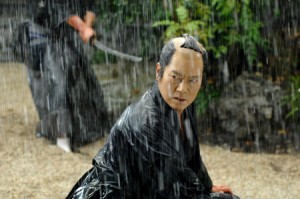JQ Magazine: Film Review – ‘Sword of Desperation’ and ‘The Last Ronin’ at JAPAN CUTS 2011

A scene from 'Sword of Desperation,' screened in New York last week as part of the JAPAN CUTS film festival. (Courtesy of Japan Society)
By Paul Benson (Fukui-ken, 2006-08) for JQ magazine. Paul is a New York-based freelance translator who has handled assignments ranging from securities law to cookbooks.
This past week I had the pleasure of seeing two films in Japan Society’s annual JAPAN CUTS film festival. The festival runs from July 7-21, with 32 films (nearly all of them premieres). I was instantly drawn to JAPAN CUTS’ only two jidaigeki 時代劇 samurai films in the series, Sword of Desperation 「必死剣鳥刺し」 and The Last Ronin 「最後の忠臣蔵」. The films were wonderful, and I encourage you to seek them out.
Sword of Desperation (2010, dir. Hideyuki Hirayama) is a poised and powerful film of feudal intrigues and expert swordsmen, a fine addition to the chanbara チャンバラ (“sword-fighting”) genre. Set in the Edo Period (1600-1868), Sword of Desperation has all the genre’s usual devices: a gradual build-up to an outburst of action, an alienated master swordsman, and conflicts of duty and heart.
The film’s first half beautifully establishes the circumstances, characters and their relationships. Etsushi Toyokawa plays the character Sanzaemon Kanemi, a master swordsman, who serves the daimyo Tabu Ukyō (Jun Murakami). At the start of the film (set three years ago), Kanemi murders his master’s favorite concubine, Lady Renko (Megumi Seki), just after the annual spring Noh performance. It soon becomes clear that Kanemi acted to stop Lady Renko from further manipulating the daimyo and damaging the domain’s administration. Kanemi is given a light sentence—a year of house arrest and a meager pay decrease—and he is allowed to return to service afterward. Yet, he soon finds himself losing his wife Mutsue (Naho Toda), faced with the affections of his niece, and lost in the intrigues of others, a situation to which blood is the only way out.
While the pacing of the film might feel disjointed and sluggish to the unfamiliar, anyone acquainted with the chanbara genre is in for a treat. The previous two chanbara films I’ve seen are When the Last Sword Is Drawn 「壬生義士伝」 (2003, dir. Yōjirō Takita) and Sword of Doom 「大菩薩峠」 (1966, dir. Kihachi Okamoto). These didn’t disappoint, and neither does Sword of Desperation. The film has beautiful sets and scenery, a simple but moving plot, and a great twist at the end.
The second jidaigeki film was The Last Ronin (2010, dir. Sugita Shigemichi), a dramatic and heartfelt epic featuring a blockbuster cast. The Last Ronin is a very different film from Sword of Desperation, and is more akin to a made-for-television-movie than a chanbara film. Viewers will be attracted to The Last Ronin simply because of its cast. Koichi Sato and Koji Yakusho give passionate performances and bring the drama to life. Film buffs might recall Koichi Sato’s performances in When the Last Sword Is Drawn and Sukiyaki Western Django (2007, dir. Takashi Miike). It’s hard to tell who’s more well-known; Koji Yakusho recently starred in 13 Assassins「十三人の刺客」 (2010, dir. Takashi Miike) and is famous from his performance in Shall We Dance? (1996, dir. Masayuki Suo).
The film’s story takes place sixteen years after the legendary chūshingura 忠臣蔵 (Treasury of Loyal Retainers) incident in 1702, where the Akō daimyo (Asano Naganori) is ordered to commit seppuku after drawing his sword and trying to kill Kira Yoshinaka. Historically, the exact reasons Asano had for wanting Kira dead are unclear, but in the end Kira went unpunished. The Akō domain samurai (now ronin), led by former chief retainer Kuranosuke Oishi, patiently plan and wait two years before valiantly avenging their lord by assaulting Kira’s home and killing him. Sixteen years after the attack on Kira’s home, the film begins by following Kichiemon Terasaka (Koichi Sato), the sole survivor of the Akō ronin’s attack (the rest committed seppuku). Terasaka was ordered by Kuranosuke Oishi (Kataoka Nizaemon), the Akō daimyo’s chief retainer, to not join his fellow warriors as they commit seppuku to follow their lord into death. Instead, Terasaka was ordered to travel Japan to find and help the families of his dead comrades.
On his way to attend the seventeenth anniversary of the chūshingura incident, Terasaka spots another man, Magozaemon Senō (Koji Yakusho), a former fellow warrior who ran the day before the attack sixteen years before. The film follows both Terasaka, who searches for Magozaemon to learn why he ran off, and Magozaemon—“Magoza,” whom we learn is caring for “Kane” (Nanami Sakuraba), a young woman of uncertain lineage. The rest of the film untangles and resolves the many questions brought up: why Magozaemon ran the day before the attack, why he is in hiding, who the young woman Kane is, etc. You’ll have to see the film to find out how the story unfolds.
All in all, JAPAN CUTS featured two incredible jidaigeki films. Not to give all praise, Western viewers unaccustomed to Japanese films might find criticism in their length and pacing. The Last Ronin is over two hours long, and it takes its time developing and emphasizing the emotional tensions. Sword of Desperation is somewhat shorter but nevertheless gradually builds to its violent climax. I believe the films’ strengths far outweigh this critique, but it’s something to keep in mind. If you’re a fan of medieval Japan, samurai, jidaigeki or chanbara, you should definitely see these films.
For more on JAPAN CUTS, visit www.japansociety.org/japancuts.


Comments are closed.